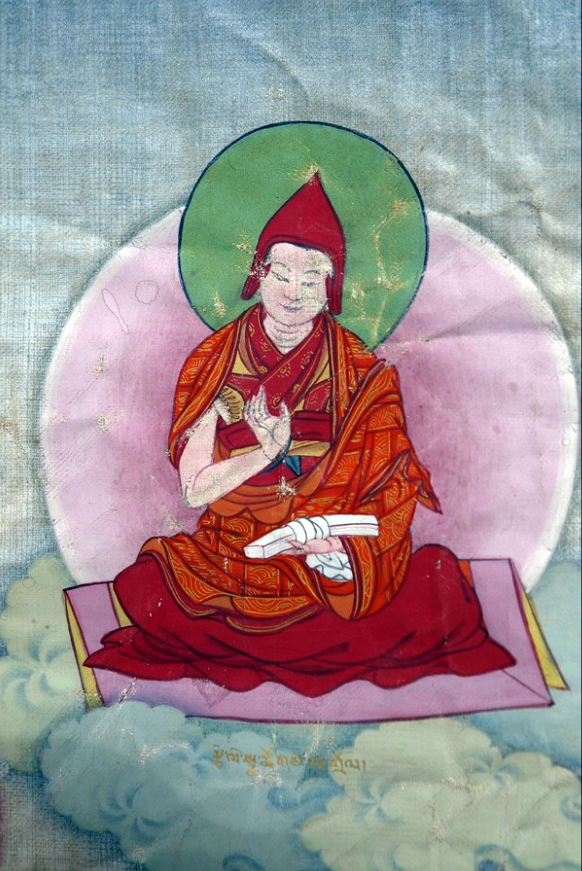
- This event has passed.
Samatha and Vipashyana in the Mahamudra Perspective. Samatha und Vipashyana in der Mahamudra Perspektive
April 13, 2018 - April 17, 2018

As the teachings about meditation from different Buddhist traditions become accessible in our society, as well as the different adaptations of the now trendy mindfulness practices, confusion grows about what the terms samatha and vipashyana truly cover.
Although stillness of mind or the state of nonthought generally is samatha, vipashyana does not depend exclusively upon this state of stillness.
Let us explore, and put into practice, the meaning of these two terms and their related meditations in the perspective of Mahamudra.
One should first understand what samatha and vipashyana mean in the general vehicles (shravakayana and mahayana), and what these terms primarily mean in the context of the Mahamudra system of definitive meaning (ngedön). The terms samatha and vipashyana appear in most of the higher and lower vehicles. In some contexts samatha demonstrates the word meditation (dhyana, samten) while vipashyana points to discriminating knowledge (prajna, sherab).
Their respective characteristics are mentioned in the Cloud of Jewels Sutra:
Samatha is one-pointed attention. Vipashyana is the individual discrimination of phenomena, correctly and exactly as they are.
In terms of their function, the sutra continues:
Samatha suppresses disturbing emotions, while Vipashyana is utterly purifying disturbing emotions.
In this way, both are causes for nirvana.
As to their divisions, there are two, as described in the Sutra of Unraveling the intent:
Samatha and vipashyana are of two kinds: resulting from knowledge and resulting from oral instructions.
As for resulting from knowledge, samatha is to keep in mind the twelve sections of Sutra (1).
To understand their meaning is vipashyana.
These days these two types are well known under the terms analytical meditation and resting meditation. Ordinary samatha meditation is certainly applied by non-Buddhist, but it doesn’t become a cause for emancipation.
This is also described in the Sutra of the King of Samadhi:
Even though mundane people meditate on emptiness they are unable to avoid fixating upon it as concrete. From that, disturbing emotions again fully evolve just like practicing the samadhi of Lhagcho.
The Buddha therefore taught that we need the supramundane or supreme samatha.
Moreover, the nine types of equanimity – the four meditation states of the gods of the realm of form (2), the four meditation states of the formless realm (3), and the Shravaka’ s samadhi of cessation – are all aspects of samatha.
Although these states include innumerable temporary qualities such as superknowledges and miraculous powers, they are useless in terms of reaching ultimate enlightenment unless they are embraced by vipashyana.
The master Aryadeva describes how vipashyana is of the most vital importance:
Though the wildfire of meditation again and again consumes the thicket of disturbing emotions it doesn’t destroy the sturdy root of egotism.
Some people achieve a certain measure of stillness but fail to bring forth the clarity of awareness, and become absorbed in the dull torpor of oblivious indifference. This brings no progress and leads one astray, as Padmasambhava said:
Without bringing forth the natural strength of awareness, a numb and inert state of stillness will never yield any progress whatsoever. So it is crucial to bring forth the steady clarity of awareness.
There are many meditators, but few who know how to meditate. It is truly important to utilize the vital points.
Notes:
(1) These are also known as the twelve aspects of excellent speech (gsung rab yan lag bcu gnyis) and are the twelve main divisions of the Buddhist Canon:
General Discourses (mdo sde);
Proclamations in Song (dbyangs su bsnyad pa);
Prophecies (lung du bstan pa);
Poetic Pronouncements (tshigs su bcad pa);
Special Aphorisms (mched du brjod pa);
Declarations (gleng gzhi);
Narratives (rtogs pa brjod pa);
Parables (de lta bu byung ba);
Succession of Former Lives (skyes pa’i rabs);
Extensive Sayings (shin tu rgyas pa’i sde);
Marvels (rmad du byung ba);
Established Doctrines (gtan la dbab pa).
(2) The first dhyana level, which is accomplished in this way, has five features: conception, discernment, joy, physical wellbeing and samadhi.
The second dhyana, which is even more peaceful, has four features: the perfect clarity in which conception and discernment have been relinquished, joy, physical wellbeing and samadhi.
The third dhyana, which is more peaceful still, has five features: equanimity in which the concept of joy has been abandoned, mindfulness, watchful awareness, physical wellbeing and samadhi.
The fourth dhyana, which is called the ultimate dhyana because it is yet more peaceful, has four features: the neutral sensation in which the sensation of physical wellbeing has been abandoned, mindfulness, the mental formation of equanimity, and samadhi.
(3) Neither Thought Nor Non-Thought, Nothing Whatsoever, Boundless Consciousness, Boundless Space
Zur Zeit sind in unserer Gesellschaft Lehren über Meditation aus den verschiedensten buddhistischen Richtungen zugänglich und zusätzlich begegnen wir noch den unterschiedlichen Adaptionen im Rahmen des gerade sehr angesagten Achtsamkeitstrainings. Dadurch entsteht Verwirrung darüber, was die Begriffe Samatha und Vipashyana wirklich beinhalten.
In diesem Kurs werden wirdie Bedeutung der beiden Begriffe unter dem Blickwinkel von Mahamudra erforschen und uns in den damit verbundenen Meditationsformen üben.

